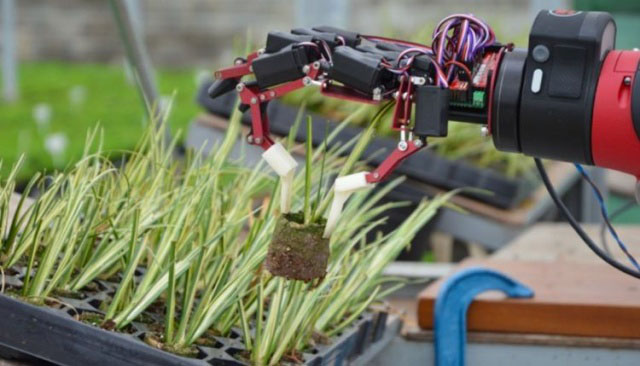Five special applications of co-robots
Date:2020-04-08
Cobots are miniaturized and flexible applications designed to work safely with humans, and are generally welcomed by small and medium-sized enterprises in industrial automation. In addition to the common manufacturing industries, such as robot arm clipping and placement operations and machine management, co-robots can also serve and be used in other non-manufacturing and non-traditional fields.

One, greenhouse plants picked. King's College London in the UK a study plan GROWBOT to develop a co-robot arms, assist Plant greenhouse workers gather plants. Robots perform repetitive tasks to solve seasonal labor shortages.
The process of plant picking involves a lot of uncertainty in sensing, and GROWBOT's robots will have a lot of variation in production to meet the different needs of different customers in relatively small batches, which will be the challenge of future greenhouse automation.
Two, Fried food. Flippy, developed by Miso Robotics, USES a co-robotic arm with multiple robotic arm terminals, Miso's artificial intelligence (AI) platform, and cloud-based monitoring capabilities. The co-robot can assist the chef in frying and flipping hamburger meat.
The system meets food safety standards of the department of labor, occupational safety and health, and can operate continuously for more than 100,000 hours. Miso's system is suitable for the 6-axis robotic arm, currently using the arm of FANUC. Flippy, which can work with people in any commercial kitchen, has been tested at CallBurger, Walmart headquarters and Dodger stadium in 2018.
Three, bartenders and baristas work. Royal Caribbean Crueses' bartenders are already in use in cruise ships, restaurants and pubs around the world. Makr Shakr also USES the KUKA robotic arm to provide bartenders to Royal Caribbean. Mitsubishi's robotic arms can also be found brewing coffee at Cafe X in Hong Kong or San Francisco.
Fourth, assist the operation. The use of robots to assist or perform surgical work is often seen as highly professional, requiring strict specifications, high performance, and more surgical training.
Nottingham Trent university (NTU) researchers developed Scoliobot for spinal surgery, which typically works in 3D print mode with two UR5 co-Robot of Universal Robots. One robotic arm, Datum Robot, tracks the patient's spine and collects data about the patient's movements, while the other, Tooling Robot, automatically adjusts its drilling movements to place the rearranged rods in the vertebrae. Such procedures require complete accuracy to reduce the risk to the patient.
Five, assist the flight pilot. Aurora Flights Sciences, a unit of Boeing, is using a TB6 co-robot as part of its Robotic Copilot concept, with the goal of building a portable and extensible suite of hardware and software tools to take automation for military and civilian aircraft to a new level.
Combining sensors, a tablet for human pilots, and flight control software, the co-robot will be designed to assist in interacting with the pilot in the Cockpit of a human pilot, reducing the pilot's load or eliminating boredom.

One, greenhouse plants picked. King's College London in the UK a study plan GROWBOT to develop a co-robot arms, assist Plant greenhouse workers gather plants. Robots perform repetitive tasks to solve seasonal labor shortages.
The process of plant picking involves a lot of uncertainty in sensing, and GROWBOT's robots will have a lot of variation in production to meet the different needs of different customers in relatively small batches, which will be the challenge of future greenhouse automation.
Two, Fried food. Flippy, developed by Miso Robotics, USES a co-robotic arm with multiple robotic arm terminals, Miso's artificial intelligence (AI) platform, and cloud-based monitoring capabilities. The co-robot can assist the chef in frying and flipping hamburger meat.
The system meets food safety standards of the department of labor, occupational safety and health, and can operate continuously for more than 100,000 hours. Miso's system is suitable for the 6-axis robotic arm, currently using the arm of FANUC. Flippy, which can work with people in any commercial kitchen, has been tested at CallBurger, Walmart headquarters and Dodger stadium in 2018.
Three, bartenders and baristas work. Royal Caribbean Crueses' bartenders are already in use in cruise ships, restaurants and pubs around the world. Makr Shakr also USES the KUKA robotic arm to provide bartenders to Royal Caribbean. Mitsubishi's robotic arms can also be found brewing coffee at Cafe X in Hong Kong or San Francisco.
Fourth, assist the operation. The use of robots to assist or perform surgical work is often seen as highly professional, requiring strict specifications, high performance, and more surgical training.
Nottingham Trent university (NTU) researchers developed Scoliobot for spinal surgery, which typically works in 3D print mode with two UR5 co-Robot of Universal Robots. One robotic arm, Datum Robot, tracks the patient's spine and collects data about the patient's movements, while the other, Tooling Robot, automatically adjusts its drilling movements to place the rearranged rods in the vertebrae. Such procedures require complete accuracy to reduce the risk to the patient.
Five, assist the flight pilot. Aurora Flights Sciences, a unit of Boeing, is using a TB6 co-robot as part of its Robotic Copilot concept, with the goal of building a portable and extensible suite of hardware and software tools to take automation for military and civilian aircraft to a new level.
Combining sensors, a tablet for human pilots, and flight control software, the co-robot will be designed to assist in interacting with the pilot in the Cockpit of a human pilot, reducing the pilot's load or eliminating boredom.
Previous Article: What are the differences between co-robot and traditional industrial robots?
Next Article: Choose the right encoder for the robot